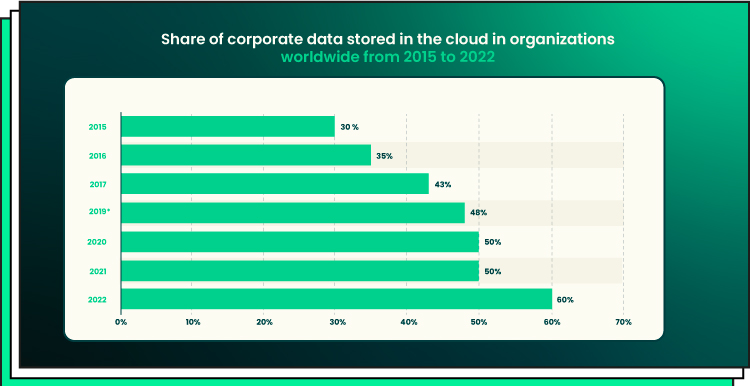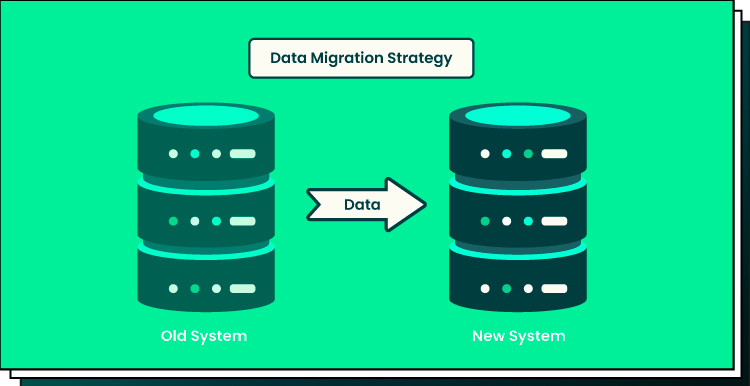In 2020, 30% of corporate data was stored in the cloud. In 2022, the number increased by two times. More and more companies choose cloud storage systems for keeping their data secure and insightful. The statistics below visualize the effect of data migration on the trends in corporate data management:

Today, we will talk about migration planning and implementation. Either if you are planning to move to the cloud or switch data management solutions, we will help you plan this process out to reach the expected outcomes. Keep reading to know why a data migration plan is important, what the main approaches to migration planning are, and what the typical migration plan looks like.
Why is it important to have a data migration strategy?
Data migration is the process that seems simple at first glance, but not for businesses that daily collect big volumes of data on their business performance, customers, internal processes, etc. A migration plan presumes allocating the necessary resources and tools and organizing the work process beforehand. By planning data migration, you will know for sure how to distribute the resources (budget, time, people, tools, data) to reach the best result.
Also, by having a data migration plan, you will be able to objectively evaluate the results of your work. You will make the concussion about the effectiveness of the chosen strategy. The conclusions will be taken into account in further data migration implementations.
In the next section, we will talk about the subtleties of data migration strategy development and the benefits it can bring.
Main approaches to migration planning
There can be many reasons why businesses decide to migrate their data from one location to another. Here are the most common ones:
- Businesses plan to modernize their system and find a more intuitive, secure, and modern solution for data storage and management.
- Their business keeps scaling, and it becomes impossible to manage the data with the existing tools.
- Companies expand their toolset and improve their digital ecosystem by adding new solutions that are incompatible with the existing data storage system and management tools.
- Businesses want to move their data from one or multiple locations to a centralized all-in-one solution. This way, they will get access to insightful analytics on their business as a whole.
- They want to move from on-premises to the cloud to improve the performance, efficiency, and security of business operations.
- Companies want to merge their activities by moving the source data to a new location where it will be stored, managed, and manipulated in a role-based way.

Based on these reasons, businesses choose between different data migration approaches. There are 2 main approaches to data migration strategy development — the big bang and trickle. Let’s discuss them in more detail:
1. Big bang approach
Under this approach, you migrate all your data at one time from the source system to the target system. One of the benefits of big bang data migration is fast implementation. However, it will require you to pause your operations and dedicate some time to the data migration process.
All the systems involved in data migration strategies of this kind are down till the process ends. This means that these systems will be unavailable for your end users and employees. As a solution, you can organize the big bang migration during public holidays, weekends, or the time when your customers don’t expect you to offer services (for example, at night hours).
The approach is frequently applied by small-size businesses that do not collect vast amounts of data. They can migrate everything at once and experience no adverse effects on their performance.
2. Trickle approach
Trickle migration is the process of transferring data that involves breaking the migration down into several phases. Each phase is performed according to the plan, scope, and timeline. As a rule, the migration phases are subdivided so that they are not overloaded with intensive workload.
Breaking the data migration strategies down into smaller sub-processes enables a business to keep functioning without pausing operations and systems. A business is at work and experiences zero downtime (or minimal downtime). The data is also subdivided into parts, and these data pieces are migrated one by one.
Compared with the big bang approach, the drawback of the trickle method is that it takes more time as the migration is done gradually. However, implementing the trickle approach reduces the possibility of game-changing errors as you keep control over the processes and can adjust them in real-time.
Forbytes recommends implementing this approach if you have a lot of data collected and stored across systems. This way, you will minimize the risk of data loss and crash and reduce downtime. As data migration experts, we can help you with data migration and provide you with support and maintenance essential for keeping your systems up and running.
10 data migration steps
Here are the main steps in the data migration strategy. Sure, each of them can be changed or adjusted to the need of a particular business. What’s more, your software engineering partner will analyze if you need to add or remove some of the steps in the data migration project.
Below, you can see the data migration process flow diagram with the main steps outlined.

1. Identify the data locations.
The first step in the data migration plan is to make a list of data locations where you store and manage your data. This can include various data analytics tools, management systems, ERP systems, etc. This will help you choose the right data management formula to store and handle all this data in a new system being secure and performant.
2. Identify the data formats, sensitivity, and types.
Audit the data your business collects. Identify data formats and types that you plan to migrate. Also, consider the data migration risks and evaluate the data’s sensitivity. It will help your software development partner prepare an effective risk management strategy.
3. Define the data migration type.
You can choose between different types of data migration. For example, migrate the historical data one time or configure regular data integration from various sources and systems. By choosing the second option, your data will be automatically synchronized (for instance, daily or once per week) in an all-in-one solution.
4. Define the project’s goals.
You need to have a clear understanding of what to expect from data migration. Make a list of project goals and identify how the data migration project is supposed to improve your business operations. For each decision, there should be a purpose. Set measurable goals on how data migration can help you improve your KPIs or ease and secure data management.
5. Define the project’s scope
After you have collected all information about the data your business stores, you can move on to defining the project’s scope. If you have no technical background, you’ll possibly need the help of a data migration specialist. Together, you will define the scope, budget, team composition, and data migration tools.
Forbytes has experience dealing with data migration projects. Our recent case study demonstrates the data migration results we delivered to one of our big ecommerce clients. Our task was to lead the data migration process from start to finish. We had to plan out, perform, manage, and configure the regular data migrations. Besides, we also performed the migration of historical data.
Being a big ecommerce enterprise with more than 250 stores, our client was collecting big volumes of siloed data. The systems where source data was stored and collected were not connected to each other. This complicated the process of insight generation and made it hard for the customer to see the overall picture of the business tendencies and performance.
As a result of migration planning and execution, we migrated all the client’s data to a secure warehouse and set up daily data synchronization across all the channels they use. Also, we exposed the data storage to insightful BI systems that turn the raw numbers into visually appealing charts and user-friendly reports.
Apart from this project, we completed numerous projects on business solution development, digital management, and digital transformation. We invite you to check them below.
In this data migration step, you should also decide on the target system by comparing the options and defining their strong and weak sides. After you choose the target system and have a deep knowledge of the source systems, you can estimate the approximate duration of the project.
The less disruptive the migration process is, the more time it can take. However, if you can afford to pause some of the business operations for the sake of quicker migration, the project can be completed shortly. As an experienced data migration company, we can develop a non-disruptive software migration plan that will help you avoid financial losses and business operation gaps.
6. Prepare the data backup
To prevent data loss when implementing data migration strategies, you need to prepare a data backup before starting the process of moving data from one place to another. This will help you feel safe about your data. Anytime, you will be able to restore all your data in case data corruption or loss happens.
7. Test the migration tools
If you are migrating big volumes of data, make sure that you chose the right data migration tools. So, test them in advance. For this, take different data types and formats and try to migrate them from the source to the target system using the migration tools. Make sure that there are no data duplicates. Check how the tool processes your requests and verify if you face no data loss or error when migrating. In case testing is successful, you can confidently move to the next data migration step.
8. Execute the migration
At this step of a data migration plan, turn to the project plan you developed with your technical team. The step involves migrating data from one source to another. Make sure that the data is cleansed and transformed to the right format if needed. Load the clean data to the target system and double-check everything.
9. Check how the final system performs
By analyzing the target system’s performance, you will ensure that the two systems connect in the right way. In case there are some connectivity issues, your technology partner will help you fix them and prevent all risks.
10. Ensure support and maintenance
Support and maintenance services are essential for you to understand if everything in the system works smoothly. If your data will regularly be updated or synchronized in real-time, the chances are that some difficulties arise. To prevent them or fix them promptly, conduct an audit of the migration process results as a part of your post-migration effort. If you detect some data gaps or errors, you can restore the data from your backup.
Data migration best practices
Here are some general pieces of advice to help you with migration planning and execution:
- Your technical team should cooperate with the operation team. This is essential in order to understand how data is leveraged in your company and what data management difficulties should be resolved with data migrations.
- Improve the quality of data before migrating it. For this, you will need to cleanse the data, change the format, restructure it, etc. This will help you make sure that you do not migrate all the data problems along with the data itself.
- Do not overload the tools and legacy system with data. If you store a lot of unnecessary or unapplicable data, there is no point in transferring it from one system to another. Instead, try to make a consistent analysis of data-related processes in your company. In our recent article, you can learn more about secure data migration tools and their use cases.
- Do not switch the system till you fully test the target system and validate it works smoothly.
Interested in data migration services?
Our 10-step guide is supposed to help you perform data migration with no errors or losses. However, most of these data migration steps require the involvement of the technical team or employees with a technical background. The technical knowledge and experience in data migration will help you perform this process securely. Also, technical experts will adjust the software migration plan to your needs, business peculiarities, and requirements.
For over 12 years, Forbytes has been helping businesses across the globe increase their revenue and optimize processes by leveraging the power of technologies. Contact us if you need help with data migration planning and execution. We will get in touch with you promptly and offer the best service at a reasonable cost.

Our Engineers
Can Help
Are you ready to discover all benefits of running a business in the digital era?

Our Engineers
Can Help
Are you ready to discover all benefits of running a business in the digital era?









